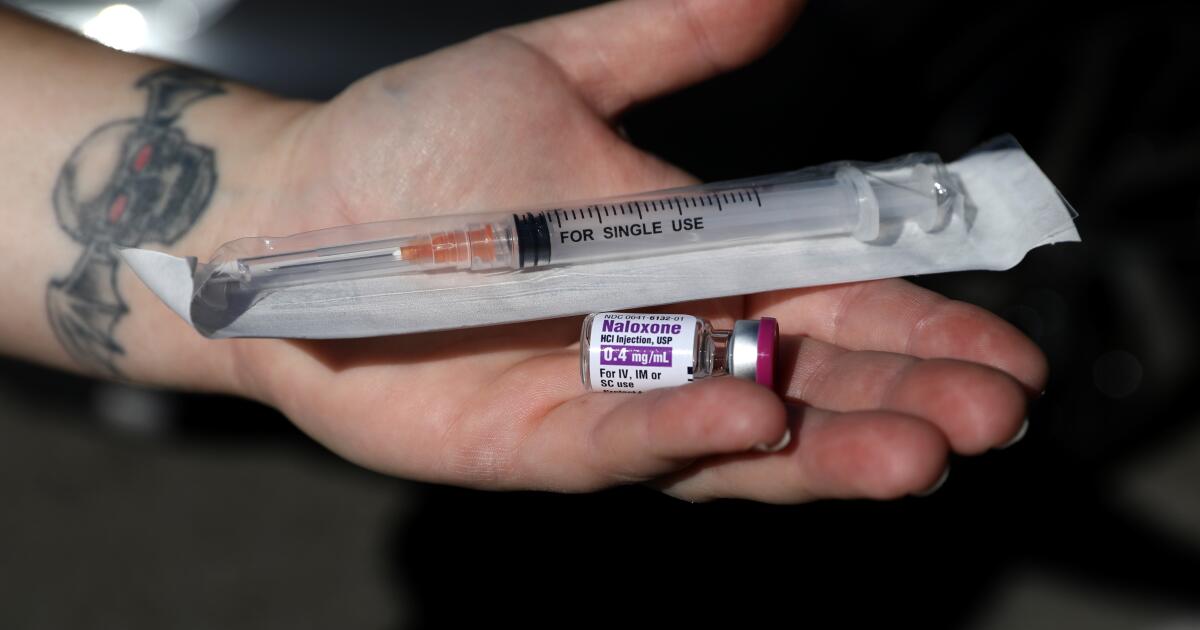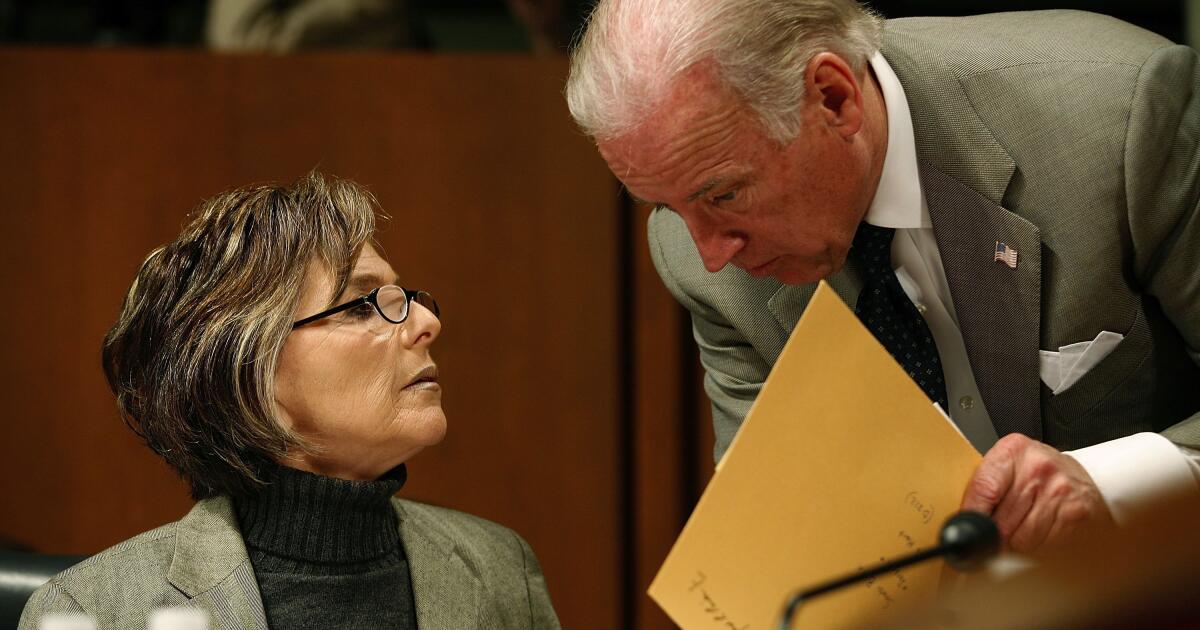Science
California pharmacies are making millions of mistakes. They’re fighting to keep that secret

Sharri Shaw walked out of the CVS on Vermont Avenue in South Los Angeles in 2019 believing she had a prescription for the pain reliever acetaminophen.
Instead the bottle held a medicine to treat high blood pressure, a problem she did not have.
Shaw began taking the pills, not learning of the mistake until six days later when a CVS employee arrived at her home, according to a lawsuit she filed last year. The employee told her not to take the tablets, the lawsuit said, before leaving the correct prescription at her door. The mistake, she said, left her stunned.
Shaw’s experience is far from an isolated event. California pharmacies make an estimated 5 million errors every year, according to the state’s Board of Pharmacy.
Officials at the regulatory board say they can only estimate the number of errors because pharmacies are not required to report them.
Most of the mistakes that California officials have discovered, according to citations issued by the board and reviewed by The Times, occurred at chain pharmacies such as CVS and Walgreens, where a pharmacist may fill hundreds of prescriptions during a shift, while juggling other tasks such as giving vaccinations, calling doctors’ offices to confirm prescriptions and working the drive-through.
Christopher Adkins, a pharmacist who worked at CVS, and then at Vons pharmacies until March, said that management policies at the big chains have resulted in understaffed stores and overworked staff.
“At this point it’s completely unsafe,” he said.
Adkins now works at an independent pharmacy company in Los Angeles. He isn’t the only pharmacist worried that heavy workloads and distractions are leading to errors.
In a survey of California licensed pharmacists in 2021, 91% of those working at chain pharmacies said staffing wasn’t high enough to provide patients adequate care.
Although the board requires pharmacies to document errors internally, inform patients about mistakes in certain cases and learn how to prevent them from occurring again, only 62% of chain pharmacists said stores were following those rules, according to the survey.
Mistakes with deadly consequences
Medication errors can harm patients, sometimes seriously.
One patient took prednisone, a powerful steroid, for 89 days after a Walgreens pharmacist in Santa Clara confused the drug with Prilosec, the heartburn drug that had actually been prescribed, according to a citation issued in June 2022. Research has shown that prednisone can decrease bone density within weeks of starting the drug, increasing the risk of fractures.
In Inglewood, a pregnant patient suffered a fall after she was given two drugs prescribed to another customer by a pharmacist at the CVS on Market Street, according to an August 2021 citation.
At a Rite Aid in Bakersfield, a pharmacist typed the wrong instructions on a prescription for anastrozole, a hormonal treatment for breast cancer. The pharmacist told the patient to take half a tablet twice a day rather than twice a week as the doctor had prescribed. The patient took the drug according to the incorrect instructions for several days, according to a January 2023 citation, suffering “adverse effects.”
Some patients have continued to take and refill the prescriptions without knowing they received the wrong drug. A pharmacist in Adelanto at the CVS on Palmdale Road gave a patient another customer’s prescription for 50-milligram tablets of Zoloft, the antidepressant, according to a February citation. The person took the wrong drug for at least seven months, refilling the prescription three times.
The pharmacy board says it investigates any report of an error that it receives from consumers or others. If the investigation finds that regulations were violated, the board can issue citations and fines and possibly take away the pharmacist’s or pharmacy’s state license.
CVS and Walgreens declined to make executives available for interviews but sent statements saying that the errors were rare. Rite Aid did not respond to messages.
“Patient safety is our highest priority,” CVS said in its statement. “When we learn of a prescription error, the first priority of our pharmacy teams is caring for the patient, taking steps to correct the error, working with the patient and the prescriber.”
CVS said it does not comment on litigation.
Walgreens said it has “a multi-step prescription filling process with numerous safety checks to minimize the chance of human error.”
“When errors do occur, we also have a robust mandatory reporting system in place that allows us to quickly identify root causes and to implement process improvements to prevent future errors,” Walgreens said.
Vons said in a statement that the company makes sure pharmacies are appropriately staffed. “We also regularly review the workflow in our pharmacies to identify ways to streamline and automate non-patient facing tasks so that our pharmacy teams can dedicate more time to serving our customers,” the company said.
Some errors have been deadly. More than 10% of malpractice claims against pharmacists were for injuries that resulted in death, according to a 2019 report by two insurance providers.
The leading cause of death was from overdoses, in which patients were given dosage strengths that were too high or incorrect instructions that multiplied the amount of medicine the patient received.
As many as 9,000 Americans die each year from prescription errors, according to one study.
‘Virtual verification’
The chain pharmacies told The Times they are using technology to give pharmacists more time to keep patients safe.
Walgreens said, for example, it uses “micro-fulfillment,” in which prescriptions are filled by robots at regional centers.
One method of automation used by CVS is mentioned in at least seven citations by the pharmacy board since July 2022. The technique, called “virtual verification,” allows a pharmacist to sign off on a prescription without seeing what pills are put in the bottle.
Instead a lower-paid technician, hired to help the pharmacist, finds the drug to fill the prescription, counts the pills and then snaps a photo just before putting the tablets in the bottle and stapling the bag shut. The pharmacist approves the prescription based on the photo rather than actually observing the pills.
According to a June 2022 citation, one patient received a bottle of Valtrex, which treats viral infections, rather than the prescribed Keflex, which treats bacterial illnesses, from the CVS on Lankershim Boulevard in North Hollywood.
“Pharmacist verification based on the photograph … obstructs the pharmacist’s ability to verify the prescription,” the regulators wrote on the citation, which imposed a $5,000 fine.
Since those citations were issued for errors, the board agreed to withdraw the part of its findings related to virtual verification at five pharmacies after meeting with CVS executives, according to a letter the board sent to the company. The executives told board officials that they had improved the process, including by making it easier for pharmacists to see the pills in the photographs. The board said it “remains concerned” that relying on photos could increase errors, the letter said. CVS told the board it has not seen an increase.
The fight for more accountability
Rarely does the public learn of the mistakes. Not only does the state not require the reporting of errors, but the big pharmacy companies often ask consumers to sign agreements demanding that they take any dispute not to court but to private arbitration panels.
Patients typically agree to arbitration when they are asked to click a box to accept the company’s terms and conditions when they pick up a prescription.
“You agree that CVS and you each waive the right to trial by a jury,” states the CVS agreement.
To begin understanding the frequency of the mistakes, the pharmacy board sponsored a bill that would require pharmacies to report every error — not publicly but to a third party outside the government. The bill would also give the pharmacist responsible for the store the ability to increase staffing if they believe the workload has become too heavy to keep patients safe.
The legislation is opposed by the California Community Pharmacy Coalition, a lobbying group representing retail pharmacies, including the big chains. The coalition has told legislators that the pharmacy staffing requirements are too rigid and that it does not want the pharmacy board to have access to the error reports, among other objections with the bill. The coalition did not respond to a request for comment.
Language in the bill being debated in Sacramento states that the board would not get access to the reports — and neither would the public. Instead the reports would be kept confidential. The third-party group receiving the error reports would periodically provide information to the pharmacy board, including how many mistakes have been reported.
The pharmacy board said it hopes to use the information to learn more about what is causing the errors and what can be done to reduce them. The bill would allow the board to publish de-identified information compiled from the data in the reports.
The bill, AB 1286, authored by Assemblymember Matt Haney, a San Francisco Democrat, has passed the Assembly and is now before the state Senate.
“Shockingly, there’s no centralized reporting mechanism for medication errors,” Haney said in an interview. “There should be transparency, and the Board of Pharmacy should have the authority to respond to protect patients. That’s not happening right now.”
Two years ago, the state Legislature passed a bill that banned chain pharmacies from setting quotas for pharmacists on the numbers of prescriptions filled, vaccines given or other activities during a shift. The law’s goal was to make the chain pharmacies safer.
In the 2021 survey, taken before that bill passed, 73% of chain pharmacists said their employer monitored the number of prescriptions filled and 62% said the company monitored the average time it took them to fill a prescription.
Despite the new law, some chain pharmacies have continued to require pharmacists to meet quotas, according to citations issued by the board. Since January 2022, at least five pharmacies have been cited for asking pharmacists to meet quotas.
CVS set quotas and measured pharmacists on the number of vaccinations they gave each week, according to a March citation issued to the company’s pharmacy in Ripon, a town in the Central Valley. The citation included a $10,000 fine.
CVS declined to answer questions about the citation. It said it did not set quotas for pharmacists or pharmacy technicians.
A pharmacy board inspection at a Walgreens in Citrus Heights in August of last year found that the store had set quotas for pharmacists on the number of COVID-19 tests dispensed and vaccinations given.
The quota was “expressly encouraged by Walgreens corporate ownership,” the citation said. The pharmacy was fined $50,000, and an additional $5,000 for the inspectors’ finding that a pharmacist had dispensed a prescription of atenolol, a blood pressure medicine, without consulting with the customer about how to safely take it. That consultation is required by state law if the drug hasn’t been given to the patient previously.
Walgreens said it disagreed with the citation and was challenging it. “Walgreens does not utilize quotas for pharmacists or pharmacy technicians,” the company said, “and was in compliance with the new law before it went into effect.”
In a nationwide move last fall, Walgreens announced that it would no longer evaluate its pharmacy staff on any task-based metrics.
Adkins, the former chain pharmacist, said that when he began working at CVS pharmacies in the Bay Area in 2020, he accidentally gave a customer another patient’s prescription.
He said he was the only person in the pharmacy at the time.
“I was having to go back and forth between the register and filling prescriptions and answering the phones, and one patient came in to pick up a medication, which wasn’t ready because I was behind,” Adkins said. “So I had to go get it ready really quickly.”
He gave the customer her prescription and realized after she left that he had made a mistake.
Adkins said he quickly called the customer, finding she was still in the parking lot. Although the patient ultimately received the correct prescription, he said, she was angry at the dangerous mistake.
“It was my fault,” Adkins said. He said he believes it would not have happened if he’d had staff to help him.
“The public does not realize what’s going on behind the counter,” he said.

Science
Live poultry markets may be source of bird flu virus in San Francisco wastewater

Federal officials suspect that live bird markets in San Francisco may be the source of bird flu virus in area wastewater samples.
Days after health monitors reported the discovery of suspected avian flu viral particles in wastewater treatment plants, federal officials announced that they were looking at poultry markets near the treatment facilities.
Last month, San Francisco Public Health Department officials reported that state investigators had detected H5N1 — the avian flu subtype making its way through U.S. cattle, domestic poultry and wild birds — in two chickens at a live market in May. They also noted they had discovered the virus in city wastewater samples collected during that period.
Two new “hits” of the virus were recorded from wastewater samples collected June 18 and June 26 by WastewaterSCAN, an infectious-disease monitoring network run by researchers at Stanford, Emory University and Verily, Alphabet Inc.’s life sciences organization.
Nirav Shah, principal deputy director of the U.S. Centers for Disease Control and Prevention, said that although the source of the virus in those samples has not been determined, live poultry markets were a potential culprit.
Hits of the virus were also discovered in wastewater samples from the Bay Area cities of Palo Alto and Richmond. It is unclear if those cities host live bird markets, stores where customers can take a live bird home or have it processed on-site for food.
Steve Lyle, a spokesman for the state’s Department of Food and Agriculture, said live bird markets undergo regular testing for avian influenza.
He said that aside from the May 9 detection in San Francisco, there have been no “other positives in Live Bird Markets throughout the state during this present outbreak of highly-pathogenic avian flu.”
San Francisco’s health department referred all questions to the state.
Even if the state or city had missed a few infected birds, John Korslund, a retired U.S. Department of Agriculture veterinarian epidemiologist, seemed incredulous that a few birds could cause a positive hit in the city’s wastewater.
“Unless you’ve got huge amounts of infected birds — in which case you ought to have some dead birds, too — it’d take a lot of bird poop” to become detectable in a city’s wastewater system, he said.
“But the question still remains: Has anyone done sequencing?” he said. “It makes me want to tear my hair out.”
He said genetic sequencing would help health officials determine the origin of viral particles — whether they came from dairy milk, or from wild birds. Some epidemiologists have voiced concerns about the spread of H5N1 among dairy cows, because the animals could act as a vessel in which bird and human viruses could interact.
However, Alexandria Boehm, professor of civil and environmental engineering at Stanford University and principal investigator and program director for WastewaterSCAN, said her organization is not yet “able to reliably sequence H5 influenza in wastewater. We are working on it, but the methods are not good enough for prime time yet.”
A review of businesses around San Francisco’s southeast wastewater treatment facility indicates a dairy processing plant as well as a warehouse store for a “member-supported community of people that feed raw or cooked fresh food diets to their pets.”
Science
Be grateful for what you have. It may help you live longer

Death may be inevitable, but that hasn’t stopped health researchers from looking for ways to put it off as long as possible. Their newest candidate is something that’s free, painless, doesn’t taste bad and won’t force you to break a sweat: Gratitude.
A new study of nearly 50,000 older women found that the stronger their feelings of gratitude, the lower their chances of dying over the next three years.
The results are sure to be appreciated by those who are naturally inclined toward giving thanks. Those who aren’t may be grateful to learn that with practice, they might be able to enhance their feelings of gratitude and reap the longevity benefits as well.
“It’s an exciting study,” said Joel Wong, a professor of counseling psychology at the University of Indiana who researches gratitude interventions and practices and wasn’t involved in the new work.
Mounting evidence has linked gratitude with a host of benefits for mental and physical health. People who score higher on measures of gratitude have been found to have better biomarkers for cardiovascular function, immune system inflammation and cholesterol. They are more likely to take their medications, get regular exercise, have healthy sleep habits and follow a balanced diet.
Gratitude is also associated with a lower risk of depression, better social support and having a greater purpose in life, all of which are linked with longevity.
However, this is the first time researchers have directly linked gratitude to a lower risk of earlier death, Wong and others said.
“It’s not surprising, but it’s always good to see empirical research supporting the idea that gratitude is not only good for your mental health but also for living a longer life,” Wong said.
Study leader Ying Chen, an empirical research scientist with the Human Flourishing Program at Harvard University, said she was amazed by the dearth of studies on gratitude and mortality. So she and her colleagues turned to data from the Nurses Health Study, which has been tracking the health and habits of thousands of American women since 1976.
In 2016, those efforts included a test to measure the nurses’ feelings of gratitude. The women were asked to use a seven-point scale to indicate the degree to which they agreed or disagreed with six statements, including “I have so much in life to be thankful for” and “If I had to list everything I felt grateful for, it would be a very long list.”
A total of 49,275 women responded, and the researchers divided them into three roughly equal groups based on their gratitude scores. Compared with the women with the lowest scores, those with the highest scores tended to be younger, more likely to have a spouse or partner, more involved in social and religious groups, and in generally better health, among other differences.
The average age of nurses who answered the gratitude questions was 79, and by the end of 2019, 4,068 of them had died. After accounting for a variety of factors such as the median household income in their census tract, their retirement status, and their involvement in a religious community, Chen and her colleagues found that the nurses with the most gratitude were 29% less likely to have died than the nurses with the least gratitude.
Then they dug deeper by controlling for a range of health issues, including a history of heart disease, stroke, cancer and diabetes. The risk of death for the most grateful women was still 27% lower than for their least grateful counterparts.
When the researchers considered the effects of smoking, drinking, exercise, body mass index and diet quality, the risk of death for the nurses with the most gratitude remained lower, by 21%.
Finally, Chen and her colleagues added in measures of cognitive function, mental health and psychological well-being. Even after accounting for those variables, the mortality risk was 9% lower for nurses with the highest gratitude scores.
The findings were published Wednesday in JAMA Psychiatry.
Although the study shows a clear link between gratitude and longevity, it doesn’t prove that one caused the other. While it’s plausible that gratitude helps people live longer, it’s also possible that being in good health inspires people to feel grateful, or that both are influenced by a third factor that wasn’t accounted for in the study data.
Sonja Lyubomirsky, an experimental social psychologist at UC Riverside who studies gratitude and was not involved in the study, said she suspects all three things are at work.
Another limitation is that all of the study participants were older women, and 97% of them were white. Whether the findings would extend to a more diverse population is unknown, Wong said, “but drawing on theory and research, I don’t see a reason why it wouldn’t.”
There can be downsides to gratitude, the Harvard team noted: If it’s tied to feelings of indebtedness, it can undermine one’s sense of autonomy or accentuate a hierarchical relationship. Lyubomirsky added that it can make people feel like they’re a burden to others, which is particularly dangerous for someone with depression who is feeling suicidal.
But in most cases, gratitude is an emotion worth cultivating, Lyubomirsky said. Clinical trials have shown that gratitude can be enhanced through simple interventions, such as keeping a gratitude journal or writing a thank-you letter and delivering it by hand.
“Gratitude is a skill that you can build,” she said.
And like diet and exercise, it appears to be a modifiable risk factor for better health.
Lyubomirsky has found that teenagers who were randomly assigned to compose letters of gratitude to their parents, teachers or coaches took it upon themselves to eat more fruits and vegetables and cut back on junk food and fast food — a behavior not shared by classmates in a control group. Perhaps after reflecting on the time, money and other resources invested in them, the teens were inspired to protect that investment, she said.
More research will be needed to see whether interventions like these can extend people’s lives, but Chen is optimistic.
“As the evidence accumulates, we’ll have a better understanding of how to effectively enhance gratitude and whether it can meaningfully improve people’s long-term health and well-being,” she said.
Science
Drug can amplify naloxone's effect and reduce opioid withdrawals, study shows

Naloxone has long been hailed as a life-saving drug in the face of the opioid epidemic. But its capacity to save someone from an overdose can be limited by the potency of the opioid — a person revived by naloxone can still overdose once it wears off.
Stanford researchers have found a companion drug that can enhance naloxone’s effect — and reduce withdrawal symptoms. Their research on mice, led by Stanford University postdoctoral scholar Evan O’Brien, was published today in Nature.
Typically, overdose deaths occur when opioids bind to the part of the brain that controls breathing, slowing it to a stop. Naloxone reverses overdoses by kicking opioids off pain receptors and allowing normal breathing to resume.
However, it is only able to occupy pain receptors for 30 to 90 minutes. For more potent opioids, such as fentanyl, that may not be long enough.
To determine how the naloxone companion drug, which researchers are calling compound 368, might boost naloxone’s effectiveness, researchers conducted an experiment on pain tolerance in mice, said Jay McLaughlin, a professor of pharmacology at the University of Florida. How quickly would mice pull their tails out of hot water, depending on which combination of opioids and treatments they were given?
Mice that were injected with only morphine did not respond to the hot water — given their dulled pain receptors. Mice given morphine and naloxone pulled their tails out within seconds. No surprises yet.
When the dosage of naloxone was reduced and compound 368 was added, the compound was found to amplify naloxone’s effects, as if a regular dose was used. When used on its own, the compound had no effect, indicating that it is only helpful in increasing the potency of naloxone.
What researchers did not expect, however, was that the compound reduced withdrawal symptoms.
McLaughlin said withdrawal is one reason that people who have become physically dependent on opioids may avoid naloxone.
“Opioid withdrawal will not kill you, but I have talked to a number of people who have gone through it, and they have all said the same thing: … ‘I wished I was dead,’” McLaughlin said. “It has a massive range of nasty, horrible effects.”
The idea that the compound could amplify naloxone’s effect at a lower dosage, while limiting withdrawal symptoms, indicates that it may be a “new therapeutic approach” to overdose response, McLaughlin said.
The research team said their next step is to tweak the compound and dosage so that the effects of naloxone last long enough to reverse overdoses of more potent drugs.
Though the compound is not yet ready for human trials, the researchers chose to release their findings in the hope that their peers can double check and improve upon their work, said Susruta Majumdar, another senior author and a professor of anesthesiology at the Washington University School of Medicine in St. Louis.
“We may not be able to get that drug into the clinic, but somebody else may,” Majumdar said. He added: “Let them win the race.”
-

 Politics1 week ago
Politics1 week agoPopular Republican and Trump running mate contender makes first Senate endorsement in 2024 races
-

 News1 week ago
News1 week agoToplines: June 2024 Times/Siena Poll of Registered Voters Nationwide
-

 Politics1 week ago
Politics1 week agoFox News Politics: Trump Ungagged…Kinda
-

 Politics1 week ago
Politics1 week agoObama again stepping into role as Joe's closer ahead of Trump v Biden rematch
-

 News1 week ago
News1 week agoIowa floodwaters breach levees as even more rain dumps onto parts of the Midwest
-

 News5 days ago
News5 days agoVideo: How Blast Waves Can Injure the Brain
-

 Politics1 week ago
Politics1 week agoThe many faces of Donald Trump from past presidential debates
-

 Politics1 week ago
Politics1 week agoMike Kennedy advances past crowded GOP primary to secure nomination for open Utah House seat















